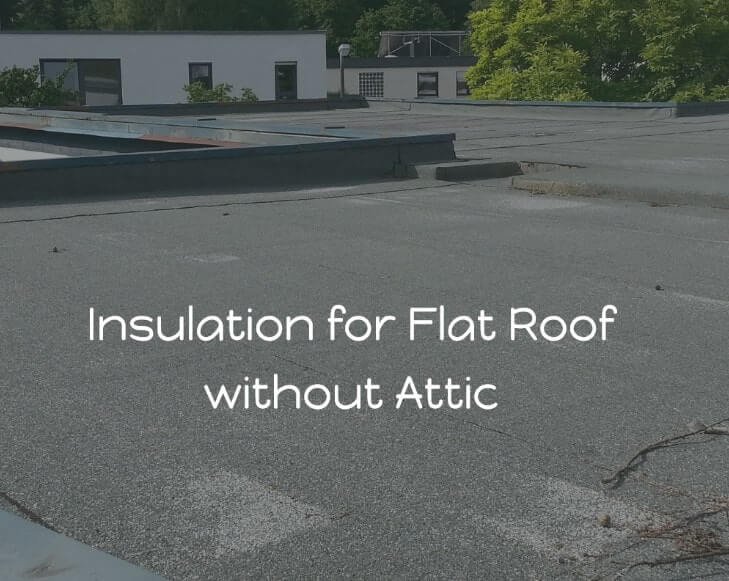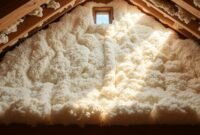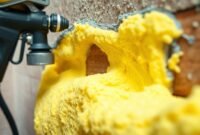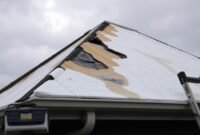Insulating a flat roof without an attic, or so-called vaulted roof, is a job that should be done while the structure is being built. Without an attic, there is less room for insulation than in a regular home. This could be a concern for the roof’s durability, as these ceilings often don’t have enough space to allow for optimum roof air flow.
Actually, there are many insulation options for a flat roof without an attic. However, a flat roof without attics has multiple holes for electrical and plumbing equipment, making it difficult to effectively seal the space.
You might need to contact an expert to walk you through a few ideas that might work in this situation, such as installing thin rigid foam boards in the ceiling with a perfect R-value or applying high-quality blown insulation to the ceiling.
This substance is excellent for filling up gaps around plumbing and electrical components. In insulating a flat roof without an attic, fiberglass insulation should never be used because there will be a lot of rot, moisture, and mold.
Flat Roof Insulation Board
Housebuilder experts in roofing advised that the R-value of the flat roof insulation chosen should be acceptable. Using board insulation also can answer the question ‘how to insulate an existing flat roof’ since it is easier to apply to an existing flat roof. There are some types of flat roof insulation board like Polyiso, EPS and XPS.

Polyisocyanurate (Polyiso) rigid foam is the most expensive yet highly recommended insulation. Expanded Polystyrene (EPS) and Extruded Polystyrene (XPS) are other excellent choices.
- Polyisocyanurate (Polyiso)
Polyiso is a closed cell foam insulation board available in thicknesses ranging from one to four inches. This material has the advantage of being light, resilient, and jointless, with excellent thermal insulation capabilities. It clings to the surface perfectly and serves as a superb foundation for the application of the outermost coat.
This type of board insulation is particularly effective in hotter areas. When the weather is perfectly temperate, this is the best form of insulation to use. Polyiso insulation fails to fully insulate in extremely cold regions.
- Extruded Polystyrene (XPS)
Insulation made of extruded polystyrene (XPS) is a foam plastic used for flat roof insulation. When excellent water resistance and thermal resistance to moisture are required, XPS insulation is the best choice.
When higher compressive strength is required, this type of roofing insulation is the best option. Under black metal roofing, the usage of XPS insulation is not recommended due to heat absorption and the highest temperatures it can hold up.
- Expanded Polystyrene (EPS)
Closed cell structures with voids around the beads are found in expanded polystyrene (EPS) insulation boards, which are similarly hydrophobic. As a result, EPS insulation has a high water absorption rate. The thermal resistance of EPS insulation is lower than that of XPS insulation.
Flat Roof Spray Foam Insulation
Polyurethane spray foam is one of the best options when it comes to high-quality flat roof spray foam insulation. This material has a high R-value, is quite durable, and is easy to work with. For roofing work, closed-cell spray foam is a suitable choice. Because closed-cell spray foam is a denser type of polyurethane foam, it has a higher level of performance and stability.
Once the spray foam solution is sprayed, there is no need to maintain the flat roof. Some spray foam manufacturers are bold enough to say that anyone who installs spray foam insulation for their roof would get a 25-year warranty against leaks.
Spray foam insulation, on the other hand, is known for its ability to operate on roofs of any form or size, especially for the flat roof without an attic. Contractors may cover any defects, features, or edges on your roof without concern of leaving flaws or gaps since this substance sprays on as a liquid and expands into a durable, insulating foam.
With such options of insulation for a flat roof without an attic, the choice is all up to you. Any house builder may have different priorities. If you want an easier and more durable way to insulate your flat roof but don’t mind spending a lot of money, spray foam is the way to go.
If you’re concerned about your budget but still want the greatest quality, you can choose from a range of board insulation options.


